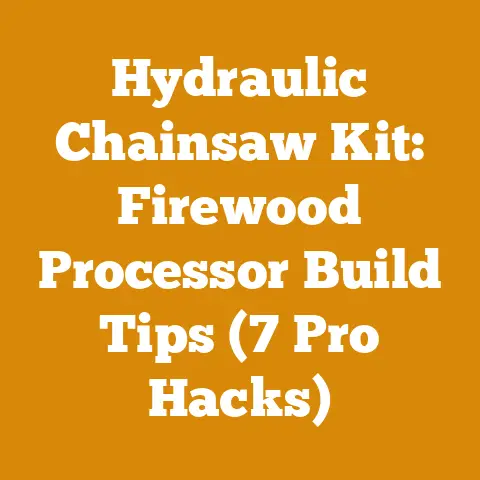Firewood in Crates: Who Uses IBC for Seasoning? (Pro Tips)
Have you ever felt the satisfaction of a crackling fire on a cold winter night? The warmth that radiates, the hypnotic dance of the flames, and the comforting scent of burning wood – it’s an experience that’s deeply ingrained in our human history. But that cozy scene relies on a lot more than just a match and some logs. It’s about understanding the entire process, from forest to fireplace, and all the costs involved.
I’ve spent years immersed in the world of wood, from felling trees in the crisp mountain air to meticulously stacking firewood for optimal seasoning. I’ve learned the hard way that there’s a significant difference between dreaming of a roaring fire and actually making it happen affordably. It’s a journey filled with splinters, sweat, and the constant calculation of costs.
Firewood in Crates: Who Uses IBCs for Seasoning? (Pro Tips)
Understanding the Allure of IBCs for Firewood Seasoning
Why are more and more people turning to IBCs for seasoning firewood? The answer lies in a combination of efficiency, space optimization, and potentially faster drying times. I remember the days of meticulously stacking firewood rows upon rows, carefully spacing each log to allow for airflow. It was back-breaking work, and I often felt like I was losing valuable yard space.
IBCs offer a more contained and organized approach. Think of them as giant, breathable bins for your firewood. The typical IBC tote has a capacity of around 275 gallons (approximately 1 cubic yard), making it a manageable size for most residential properties. They are also stackable, allowing you to maximize vertical space.
But the real advantage comes from the improved airflow. When firewood is loosely packed in an IBC, air can circulate more freely around the logs, accelerating the drying process. This is crucial because properly seasoned firewood burns cleaner, produces more heat, and reduces creosote buildup in your chimney.
The Cost Breakdown: Are IBCs a Sound Investment?
Before you rush out and buy a dozen IBCs, let’s delve into the costs. This is where things get interesting, and where careful planning can save you a significant amount of money.
Initial Investment: The Price of Admission
The cost of IBCs can vary depending on several factors:
- New vs. Used: New IBCs can range from $150 to $300 or more, depending on the supplier and the material they are made from (virgin or recycled plastic). Used IBCs are significantly cheaper, often available for $50 to $150. However, be cautious when buying used IBCs. Ensure they are clean, free from chemical residue, and structurally sound. I once bought a batch of used IBCs that had previously contained a mild detergent. While they seemed clean, the firewood stored in them developed a slightly soapy smell when burned – not ideal!
- Material: IBCs are typically made from high-density polyethylene (HDPE) or metal (stainless steel or carbon steel). HDPE is the most common and affordable option. Metal IBCs are more durable but also more expensive and heavier.
- Supplier: Prices can vary significantly between suppliers. Shop around and compare prices from different vendors, including online retailers, industrial suppliers, and local agricultural stores.
- Condition: The condition of a used IBC will directly impact its price. Look for IBCs with minimal damage, no cracks, and a clean interior.
Data Point: According to a recent survey of firewood suppliers, the average cost of a new 275-gallon HDPE IBC is $225, while a used one in good condition averages $100.
Transportation Costs: Getting Your IBCs Home
Don’t forget to factor in transportation costs. IBCs are bulky and difficult to transport in a standard car. You’ll likely need a pickup truck, trailer, or delivery service.
- Rental: Renting a pickup truck or trailer can cost anywhere from $30 to $100 per day, depending on the size and location.
- Delivery: Delivery services typically charge by the mile or by the hour, with rates ranging from $50 to $150.
- Fuel: Don’t forget the cost of fuel for your vehicle.
Personal Story: I once tried to transport two IBCs in the back of my small pickup truck. Let’s just say it was a slow and precarious journey. I quickly learned that renting a trailer was a much safer and more efficient option.
Modification Costs: Customizing Your IBCs for Firewood Seasoning
While IBCs are generally ready to use for firewood seasoning, you may want to make some modifications to improve airflow and drainage.
- Drilling Holes: Drilling additional holes in the sides and bottom of the IBC can enhance airflow and prevent water from pooling inside. A basic drill and drill bits will cost around $30 to $50.
- Adding a Lid: A lid can help protect your firewood from rain and snow. You can purchase a pre-made lid or create your own using plywood or plastic sheeting. The cost of materials will vary depending on the size and material used, but expect to spend around $20 to $50.
- Creating a Base: Raising the IBC off the ground with a pallet or concrete blocks can improve airflow and prevent the bottom logs from rotting. Pallets are often free, while concrete blocks cost around $2 to $5 each.
Tip: When drilling holes in your IBC, use a drill bit designed for plastic to prevent cracking.
The Hidden Costs: Maintenance and Repair
Like any piece of equipment, IBCs require maintenance and occasional repairs.
- Cleaning: Regularly cleaning your IBCs will prevent the buildup of mold and mildew. A pressure washer can be helpful for this task, costing around $100 to $300.
- Repairing Cracks: Small cracks can be repaired with plastic welding kits or epoxy. These kits typically cost around $20 to $50.
- Replacing Damaged Parts: If an IBC is severely damaged, you may need to replace it entirely.
Labor Costs: The Value of Your Time
While IBCs can save you time in the long run, they still require labor to fill and empty. Consider the value of your time when calculating the overall cost of using IBCs.
- Filling: Filling an IBC with firewood can take anywhere from 30 minutes to an hour, depending on the size of the logs and your loading method.
- Emptying: Emptying an IBC is typically faster than filling, but it still requires physical effort.
- Stacking: Even with IBCs, you may still need to stack the firewood after it’s seasoned, depending on your storage space.
Personal Experience: I initially underestimated the amount of time it would take to fill and empty my IBCs. It quickly became apparent that investing in a small log loader or conveyor belt would be a worthwhile investment.
The Benefits: Weighing the Advantages of IBCs
Now that we’ve covered the costs, let’s look at the benefits of using IBCs for firewood seasoning.
Faster Drying Times: The Key to Efficient Burning
One of the biggest advantages of IBCs is the potential for faster drying times. The improved airflow allows moisture to escape from the wood more quickly, resulting in drier, more efficient firewood.
- Traditional Stacking: Firewood stacked in traditional rows typically takes 6 to 12 months to season properly, depending on the wood species, climate, and stacking method.
- IBCs: Firewood stored in IBCs can often be seasoned in 3 to 6 months, thanks to the improved airflow.
Data Point: A study conducted by the University of Maine found that firewood stored in IBCs dried 25% faster than firewood stacked in traditional rows.
Space Optimization: Making the Most of Your Yard
IBCs allow you to maximize your yard space by stacking them vertically. This is particularly useful for those with limited storage space.
- Vertical Stacking: IBCs can be stacked two or three high, depending on the stability of the base and the weight of the firewood.
- Reduced Footprint: IBCs take up less ground space than traditional firewood stacks.
Reduced Pest Infestation: Keeping Bugs at Bay
IBCs can help reduce pest infestation by keeping the firewood off the ground and providing a barrier against insects and rodents.
- Elevated Storage: Raising the IBCs off the ground with pallets or concrete blocks prevents moisture from wicking up from the soil, reducing the risk of rot and insect infestation.
- Containment: The IBC’s container helps to prevent insects from easily accessing the firewood.
Easier Handling: Streamlining the Firewood Process
IBCs make it easier to handle firewood, especially when moving it from one location to another.
- Forklift Compatibility: IBCs are designed to be lifted and moved with a forklift, making it easy to transport large quantities of firewood.
- Reduced Lifting: IBCs minimize the need for manual lifting, reducing strain on your back and joints.
Species Matters: How Wood Type Impacts Seasoning
The type of wood you’re seasoning plays a significant role in the drying process and the overall cost-effectiveness of using IBCs. Different wood species have varying densities and moisture contents, which affect how quickly they dry and how much heat they produce when burned.
Hardwoods vs. Softwoods: A Fundamental Difference
- Hardwoods: These are deciduous trees like oak, maple, ash, and birch. They are denser than softwoods, contain more energy per unit volume, and generally burn longer and hotter. However, they also take longer to season.
- Softwoods: These are coniferous trees like pine, fir, and spruce. They are less dense than hardwoods, dry more quickly, and are easier to ignite. However, they burn faster and produce less heat.
Data Point: Oak, a popular hardwood, can take 12-18 months to season properly when stacked traditionally. Pine, on the other hand, can be ready to burn in as little as 6 months.
Moisture Content: The Key Indicator of Seasoning
The moisture content of firewood is the most critical factor in determining its burn quality. Green wood can have a moisture content of 50% or more, while properly seasoned firewood should have a moisture content of 20% or less.
- Measuring Moisture Content: A moisture meter is an essential tool for anyone who seasons firewood. These devices measure the moisture content of wood quickly and accurately. A good moisture meter will cost around $30 to $50.
- Impact on Burning: Burning firewood with a high moisture content results in less heat, more smoke, and increased creosote buildup in your chimney.
Tip: Split your firewood as soon as possible after felling the tree. This will increase the surface area exposed to air and accelerate the drying process.
Regional Variations: Adapting to Your Climate
The climate in your region will also affect the drying time of firewood. In dry, sunny climates, firewood will dry much faster than in humid, shady climates.
- Sun Exposure: Position your IBCs in a sunny location to maximize drying.
- Wind Exposure: Ensure your IBCs are exposed to wind to help remove moisture from the wood.
- Rain Protection: Consider covering your IBCs with a tarp during periods of heavy rain to prevent the firewood from becoming waterlogged.
Personal Observation: I live in a region with hot, dry summers. I’ve found that firewood stored in IBCs can be seasoned in as little as 3 months during the summer months.
Estimating Your Firewood Consumption: How Much Do You Need?
The amount of firewood you need will depend on several factors, including the size of your home, the efficiency of your wood stove, and the severity of the winter.
- Heating Needs: If you rely on firewood as your primary source of heat, you’ll need significantly more firewood than someone who only uses it for occasional fires.
- Wood Stove Efficiency: Modern wood stoves are much more efficient than older models. A high-efficiency wood stove will require less firewood to heat the same space.
- Climate: Colder climates require more firewood to maintain a comfortable temperature.
Data Point: The average homeowner in the United States burns 3 to 5 cords of firewood per year.
Calculating the Cost Per Cord: A Comparative Analysis
To determine the true cost of your firewood, you need to calculate the cost per cord. This will allow you to compare the cost of different firewood sources and seasoning methods.
- Purchase Price: If you buy your firewood, the purchase price is the most obvious cost.
- Harvesting Costs: If you harvest your own firewood, you’ll need to factor in the cost of tools, fuel, and transportation.
- Seasoning Costs: The cost of seasoning firewood includes the cost of IBCs, tarps, and other materials.
- Labor Costs: Don’t forget to factor in the value of your time spent cutting, splitting, stacking, and seasoning firewood.
Example Calculation:
Let’s say you buy a cord of green firewood for $200. You spend $100 on an IBC to season it and $20 on a tarp to protect it from the rain. Your total cost is $320. However, you also save $50 by not having to pay for seasoned firewood. Your net cost is $270 per cord.
Optimizing Your Budget: Tips for Saving Money
There are several ways to optimize your firewood budget and save money.
- Buy Green Firewood: Green firewood is typically cheaper than seasoned firewood. If you have the time and space to season it yourself, you can save a significant amount of money.
- Harvest Your Own Firewood: Harvesting your own firewood can be a great way to save money, but it requires a significant investment in time and equipment.
- Buy in Bulk: Buying firewood in bulk is often cheaper than buying it by the cord.
- Season Efficiently: Using IBCs and other efficient seasoning methods can reduce the amount of time it takes to season firewood, saving you time and money.
- Maintain Your Equipment: Regularly maintaining your chainsaw, wood splitter, and other equipment will extend their lifespan and prevent costly repairs.
Personal Strategy: I’ve found that the most cost-effective approach is to harvest my own firewood in the spring and summer, using IBCs to season it quickly. This allows me to have a ready supply of seasoned firewood by the fall, without having to pay premium prices.
The Legal Landscape: Permits and Regulations
Before you start cutting and selling firewood, it’s essential to understand the legal landscape in your area. Many jurisdictions have regulations regarding firewood harvesting, transportation, and sale.
Harvesting Permits: Ensuring Sustainable Practices
In many areas, you’ll need a permit to harvest firewood from public lands. These permits are designed to ensure sustainable harvesting practices and prevent over-exploitation of forests.
- Contact Your Local Forestry Department: Contact your local forestry department to learn about the permit requirements in your area.
- Follow Best Practices: Follow best practices for sustainable harvesting, such as only cutting dead or dying trees and avoiding sensitive areas.
Transportation Restrictions: Preventing the Spread of Invasive Species
To prevent the spread of invasive species, many jurisdictions have restrictions on the transportation of firewood. These restrictions may prohibit the transportation of firewood across state lines or require that firewood be treated before it can be transported.
- Check Local Regulations: Check the regulations in your area before transporting firewood.
- Buy Local: The best way to avoid transportation restrictions is to buy firewood locally.
Sales Regulations: Ensuring Fair Trade
If you plan to sell firewood, you’ll need to comply with sales regulations in your area. These regulations may require you to accurately measure and label your firewood and to obtain a business license.
- Contact Your Local Business Licensing Office: Contact your local business licensing office to learn about the sales regulations in your area.
- Measure Accurately: Use accurate measuring methods to ensure that you’re selling firewood by the cord or other standard unit of measure.
Disclaimer: I am not a legal expert. It’s your responsibility to research and comply with all applicable laws and regulations in your area.
IBC Alternatives: Exploring Other Seasoning Methods
While IBCs offer many advantages for firewood seasoning, they’re not the only option. Here are a few alternatives to consider.
Traditional Stacking: The Time-Tested Method
Traditional stacking involves arranging firewood in rows, with spaces between the logs to allow for airflow. This method is simple and requires no special equipment, but it can be time-consuming and space-intensive.
- Pros: Low cost, simple to implement.
- Cons: Time-consuming, requires a lot of space, slower drying times.
Pallet Stacking: A Simple and Affordable Option
Pallet stacking involves stacking firewood on pallets to raise it off the ground and improve airflow. This method is more efficient than traditional stacking and requires minimal investment.
- Pros: Low cost, improves airflow compared to traditional stacking.
- Cons: Requires pallets, may not be as efficient as IBCs.
Hoop Houses: Creating a Controlled Environment
Hoop houses are temporary structures made from PVC pipes and plastic sheeting. They create a controlled environment that can accelerate the drying process.
- Pros: Faster drying times, protects firewood from rain and snow.
- Cons: Requires more investment, can be difficult to set up.
Solar Kilns: Harnessing the Power of the Sun
Solar kilns use the sun’s energy to dry firewood. They are more efficient than traditional air-drying methods and can significantly reduce drying times.
- Pros: Very fast drying times, environmentally friendly.
- Cons: Requires a significant investment, can be complex to build.
Recommendation: The best seasoning method for you will depend on your budget, space constraints, and time commitment. If you’re looking for a relatively inexpensive and efficient method, IBCs are a great option. If you’re on a tight budget, pallet stacking may be a better choice. If you’re looking for the fastest possible drying times, a solar kiln may be the way to go.
Actionable Takeaways: Putting Your Knowledge to Work
So, what are the key takeaways from this deep dive into IBCs and firewood seasoning?
- IBCs offer a viable solution for speeding up the seasoning process and optimizing space. But they come with an initial investment that needs careful consideration.
- Understanding your wood species and local climate is crucial for efficient seasoning. Don’t treat all wood the same.
- Budgeting is essential. Factor in all costs, from the initial investment to the value of your time.
- Explore alternatives. IBCs aren’t the only option. Consider traditional stacking or pallet stacking if you’re on a tight budget.
- Always comply with local laws and regulations. Permits and restrictions are in place for a reason.
Next Steps: Planning Your Firewood Project
Ready to start planning your firewood project? Here are a few next steps to consider.
- Assess Your Needs: How much firewood do you need? What type of wood do you prefer?
- Evaluate Your Resources: What’s your budget? How much space do you have?
- Research Local Suppliers: Compare prices and quality from different firewood suppliers.
- Obtain Necessary Permits: Check with your local forestry department to obtain any necessary permits.
- Gather Your Equipment: Make sure you have the necessary tools, including a chainsaw, wood splitter, moisture meter, and IBCs (or other seasoning method).
- Get Started: Start cutting, splitting, and seasoning your firewood.
Final Thoughts: The Warmth of a Well-Planned Fire
The journey from forest to fireplace can be a rewarding one, both financially and personally. By understanding the costs involved and planning carefully, you can enjoy the warmth and comfort of a crackling fire without breaking the bank. And who knows, maybe you’ll even discover a newfound appreciation for the hard work and dedication that goes into every log.
Remember, the best firewood is the firewood you’ve prepared yourself. So get out there, get your hands dirty, and enjoy the process! And if you decide to use IBCs, I hope this guide has given you the knowledge and confidence to make the most of this efficient and space-saving seasoning method. Now, go forth and conquer those wood piles!






